__PROJECT_OVERVIEW
TAKE ME BACK
_____origins of the research
Art engages with what is held in common. Its creation, formation, and consideration is as much part of a process, as the output of distinct and selective remembrance. It plays with the levels of inclusion and exclusion in the same way as memory does. Its meaning is always transactive as it is the result of complex and dynamic processes of interpretation, contestation and translation. Memory, as a concept and driver of my work, takes form in both literal and more abstract ways. I often explore modes of remembering and the fragmentation connected to, that by working with archival material or archiving structures. Working on different levels of legibility, both through language and other visualisations, I explore this ‘how’ we remember —how are memories shaped and how do they grow over time, that is the core of the research behind this project and the central focus of my current practice.
This ‘how’ of the remembrance, is a concept I try to explore through space and ambient, and try to translate beyond that memory. Archiving plays a role in this, in the way that it in essence is an accumulation or documentation of the evidence of the memory. To archive, is to claim a perspective, to hold accountable or to suggest a narrative. It is this archiving and structuring of my artistic outputs into contexts or over time, and shaping narrativity that is core to my research-based practice.
In the previous semester of the last year of my BA, I explored this topic in an installation titled 'Yesterday, last Monday, December 21st'.
It took form as an audio-visual installation that explored the personal and collective perceptions of memory. The installation consisted of multiple narratives —the one told by the storyline of the selection of archive photographs on the floor, the one narrated in the space over the surround sound speakers, and the one you were able to navigate through in the archived collection.
The audience was invited to move through, interact with and exist within the space, whilst guided by the sound from various voices (in different languages) describing their most vivid memory.
Whilst focusing on this concept of memory, this installation was interested specifically in remembering from a personal vs foreign perspective. The unfamiliarity with the memories played a key role here, accentuated by the use of foreign languages in the audible narration. The research and development was centred around the idea of how memories are processed and relived through dialogue and how that can be an inherent familiar ambient. Without any distinct understanding, the different voices guide you through a fragmented story of a distinct memory —an arguably universal existential feeling. With the main focus lying on how we can reconsider a foreign memory to feel familiar.
Progressing from this specific area of research within the general topic of memory, remembrance and these 'existential feelings' of memory ambient, the project that I am currently developing looks at these bigger themes from a different perspective.
Rather than focussing on the memories themselves, I want to explore the process of the memory —how it grows, how it develops, how it takes up space and manifests itself in the space. And I want to try to do that together with the audience, so rather than just watching, they can become and active part of the remembering.
‘I want to tell you about all the things I remember’ explores how text can take form as a representation of a memory. Memories are such a loose concept, in the way that they are not necessarily coherent or distinct, but rather blurred and ever evolving over time. A memory, when growing, is not held together by clear boundaries, but rather is like an ambient manifested in different forms.
That is what this work is about.
The feeling of a memory that is slightly out of reach but embodies in the world around you. Here, that memory is reconstructed through text in space.
___continuation of the research; a new project
___a map of the memory
In the performance, I am reconstructing a memory. One that has grown over time, it never existed in one coherent line or thought. Through the writing, I am trying to explore the various ways and forms in which this memory is held together and embodied. The work is not solely trying to activate this personal memory, but rather place the audience inside this memory. In the work, I am establishing a relation between the reconstruction of this memory and the physical space.
In the performance, the audience is invited to get insight into the memory, and in return, physically become part of it. They will be able to step into the map of this reconstruction.
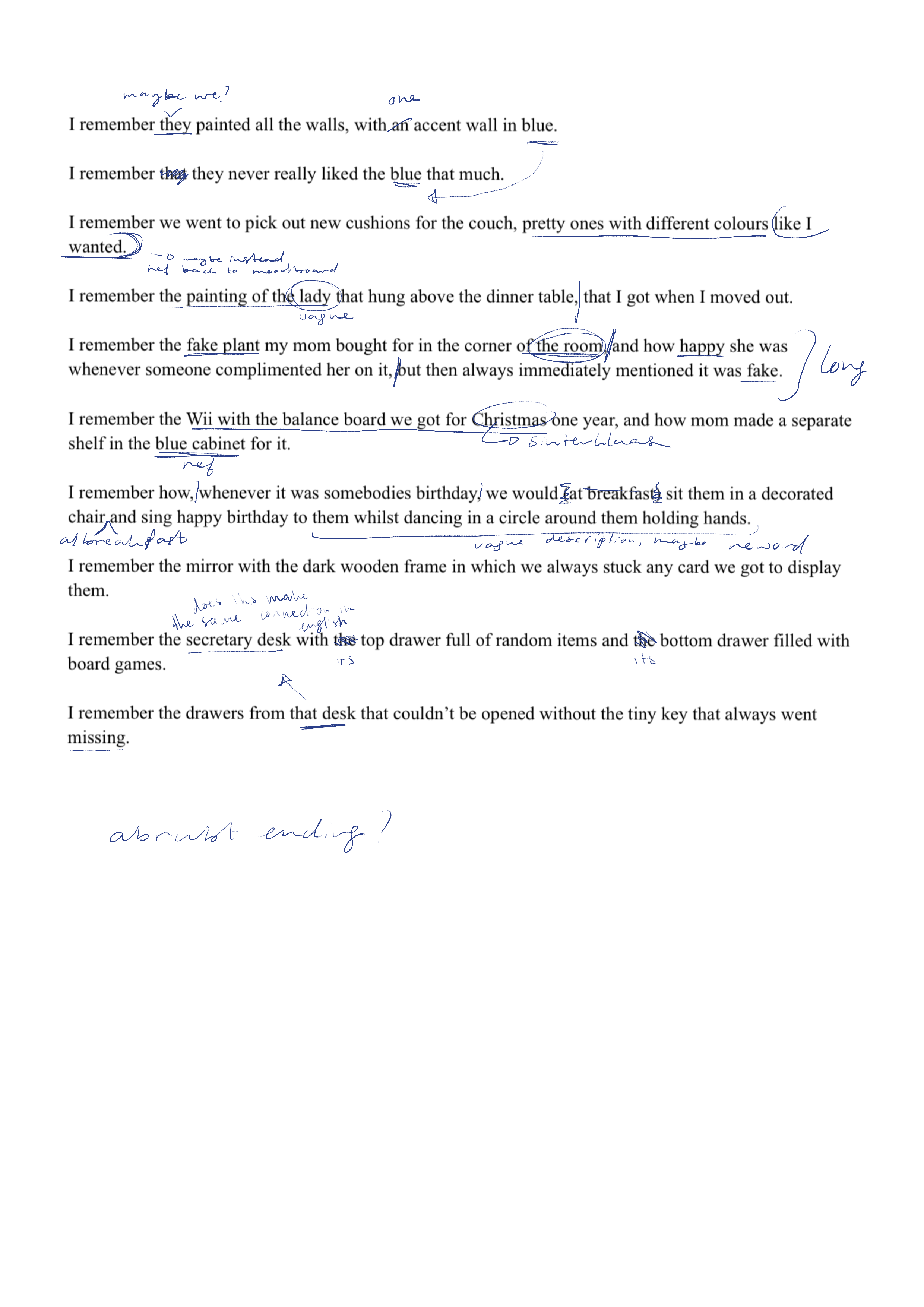
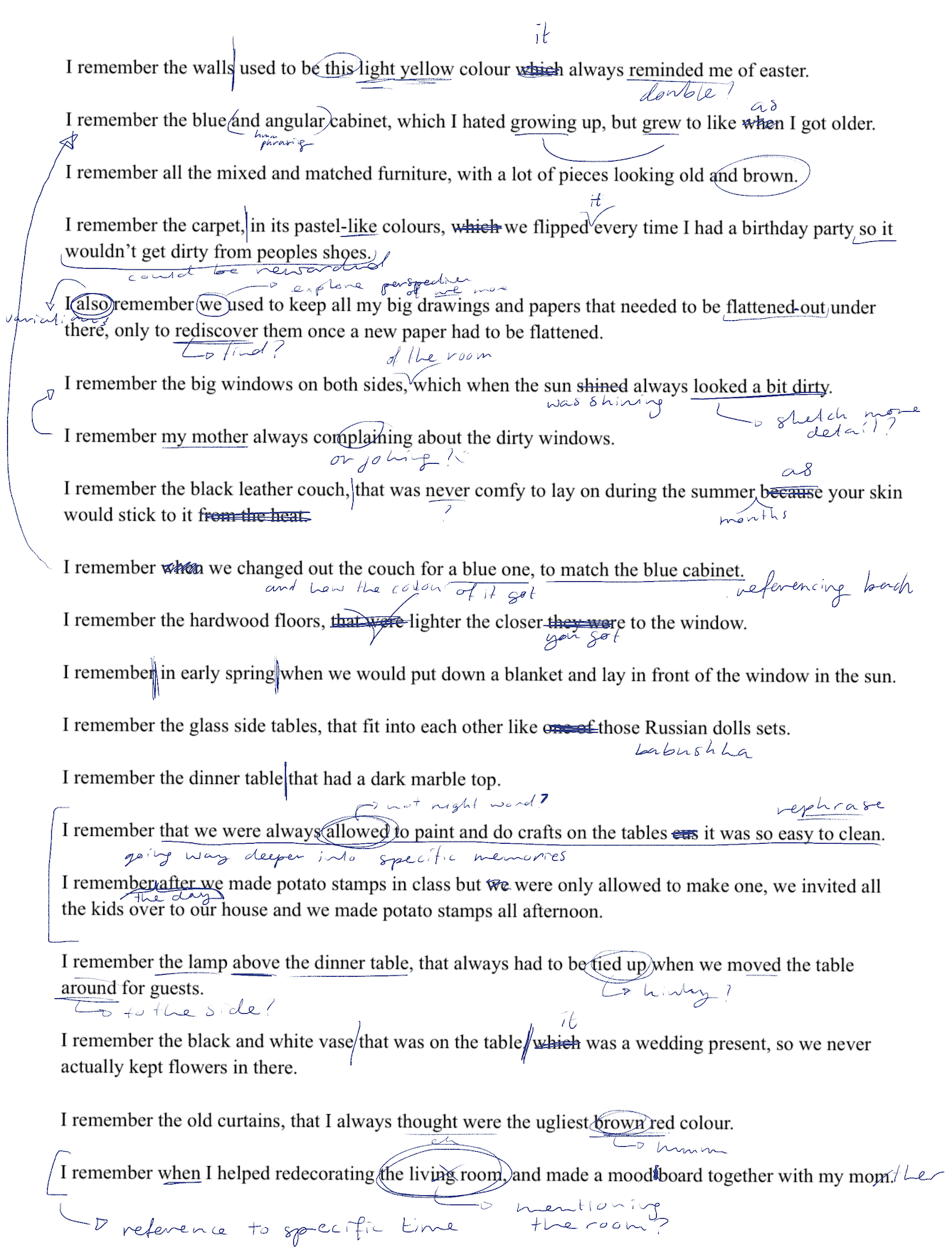
The foundations of this project lie in text, and how we can explore spatiality and time through language. The performance is structured around a text —that is improvised and adapted throughout— reconstructing a memory. It is both performed on the desktop and embodied in the room through different actions of mapping, marking and engaging of an audience into this reconstruction. The work will exist after the durational performance at the 'Reflection in a Pond' Exhibition, only as records of the remembrance, and an active archive to be explored by the visitors.
___reconstructing a memory
_____the text
this text was the output of an exercise of reconstruction. I wanted to see if I could reformat a memory in a new format, in this case: writing. By choosing the medium of language, I wanted to contrast the timeliness of a memory with the linear and temporal focus of writing. Capturing a remembered time in words ended up being a natural and intuitive process. It was as if I was recalling a story, with each element bringing forth more connections and examples —in a single stream of focus.
The memory specifically focussed on a room, or rather, it took the memory of this room as a startingpoint. It is through this, that I realised how much my memories were embodied by spaces. It was a similar theme that I explored last semester, but now finally placed in this spatial awareness.
It gave me a starting point to explore how this could be further developed into an artwork that would bring that recognition or concept to others.
I wanted to explore if there were ways how I could bridge this personal memory, and have it embody a different space. Could I work with this notion of space, and place the context of the memory into it? Mainly through tactics of mapping have I been exploring this further.
The text itself is already structured with elements of repetition and self-reference. With each line does the viewer get more insight into what kind of space this is, whilst never visually seeing it. This power of the imagination without visualisation, is what I wanted to give the main function in my work. This was the driver of exploring mainly only the textual aspect of this research, and only relying on this as a visual means.
Later, for the further development of my performance, I revisited the text. To reconsider some of the words, maybe add or rephrase some parts, or remove parts altogether. I ultimately let go of the set structure of this text and used it more as a starting point for improvisation with a base to fall back on.
the idea to perform the writing of this text, came from a variety of different inspirations. I have been researching the performance of text, in a non-spoken format. The typing, rather than speaking, to me, gives the setup an intimate feeling. It is often easier to type things, as opposed to speaking. This setup, of a computer and a projector, or video of the typing, reminds of reading over someone's shoulder or seeing a thought process, like writing a diary.
The slowness, the typing errors, the formatting, it is all part of the narrative. It is all part of a story I am trying to give you insight in.
The desktop, as the setting for the performing of the text, also is a personal and intimate one. In this day and age, our computers and phones function as an extension of our self. We use them to document our happy moments, write down things to not forget, and spend a large share of our time on or with them. The desktop is the starting point of one's place in the digital sphere. The raw and real view of the desktop, with a view of some files, the background image and anything that might pop up, is intentional, to highlight more of that intimacy —of the memory and of the performance.
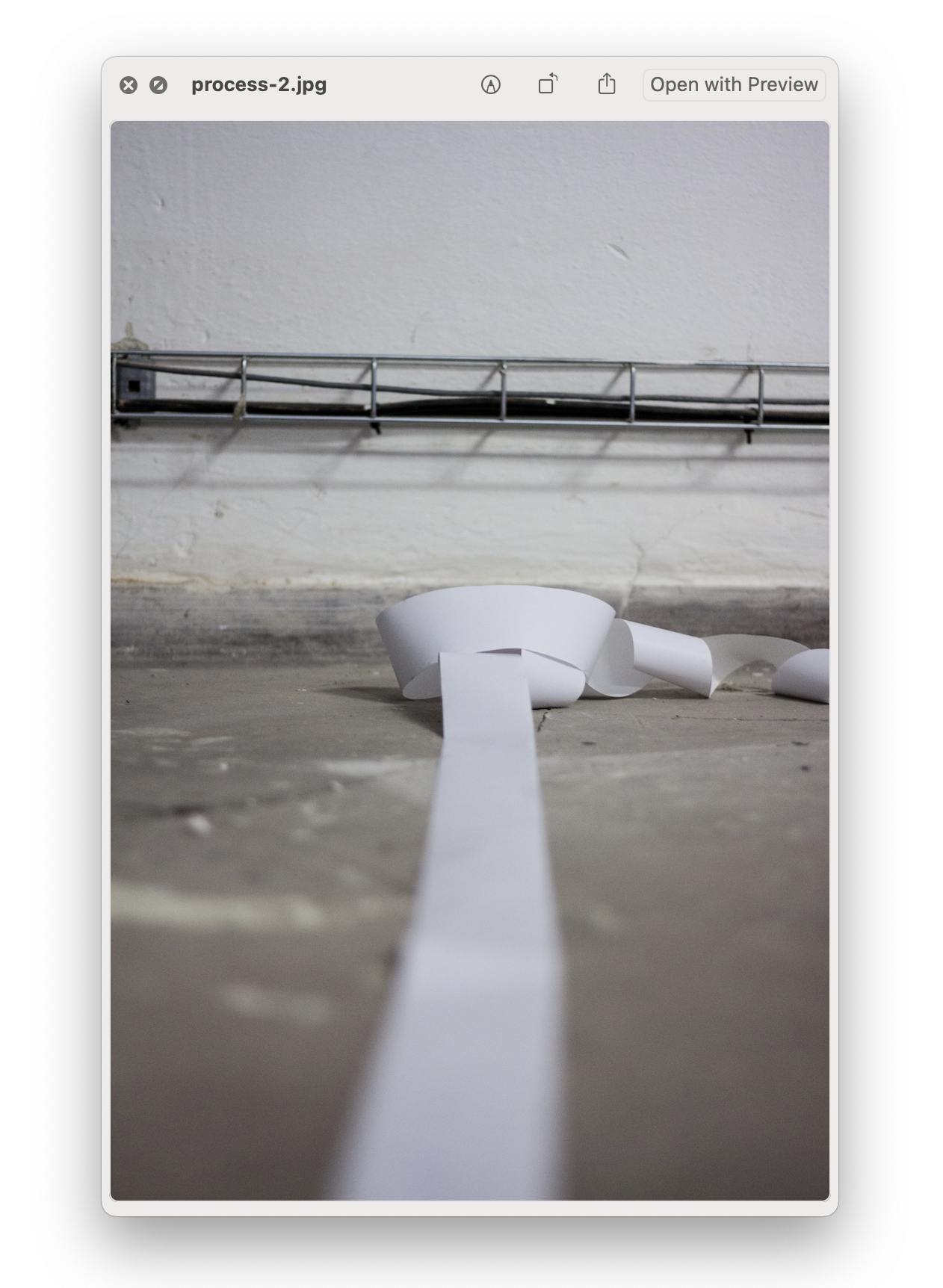
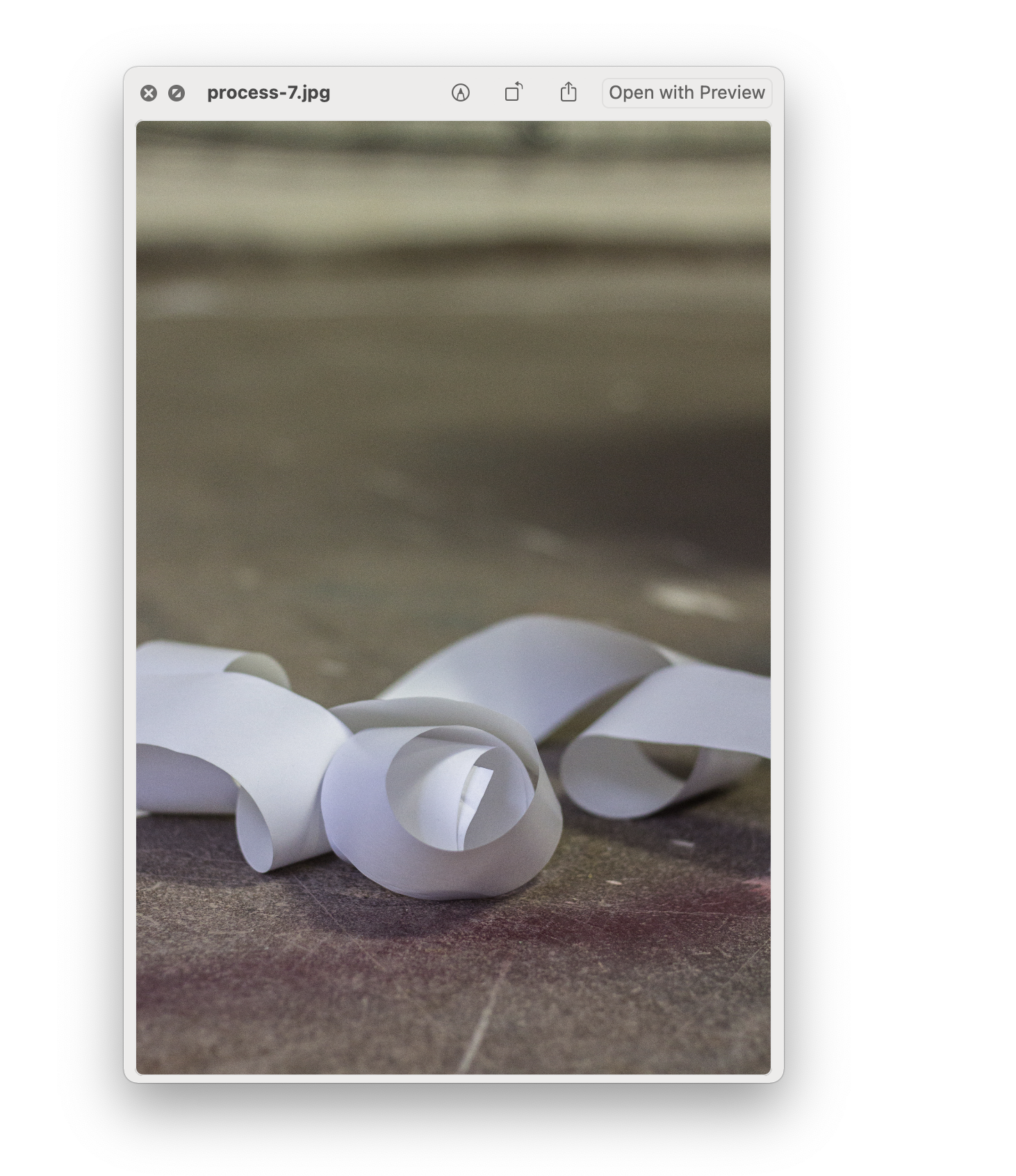
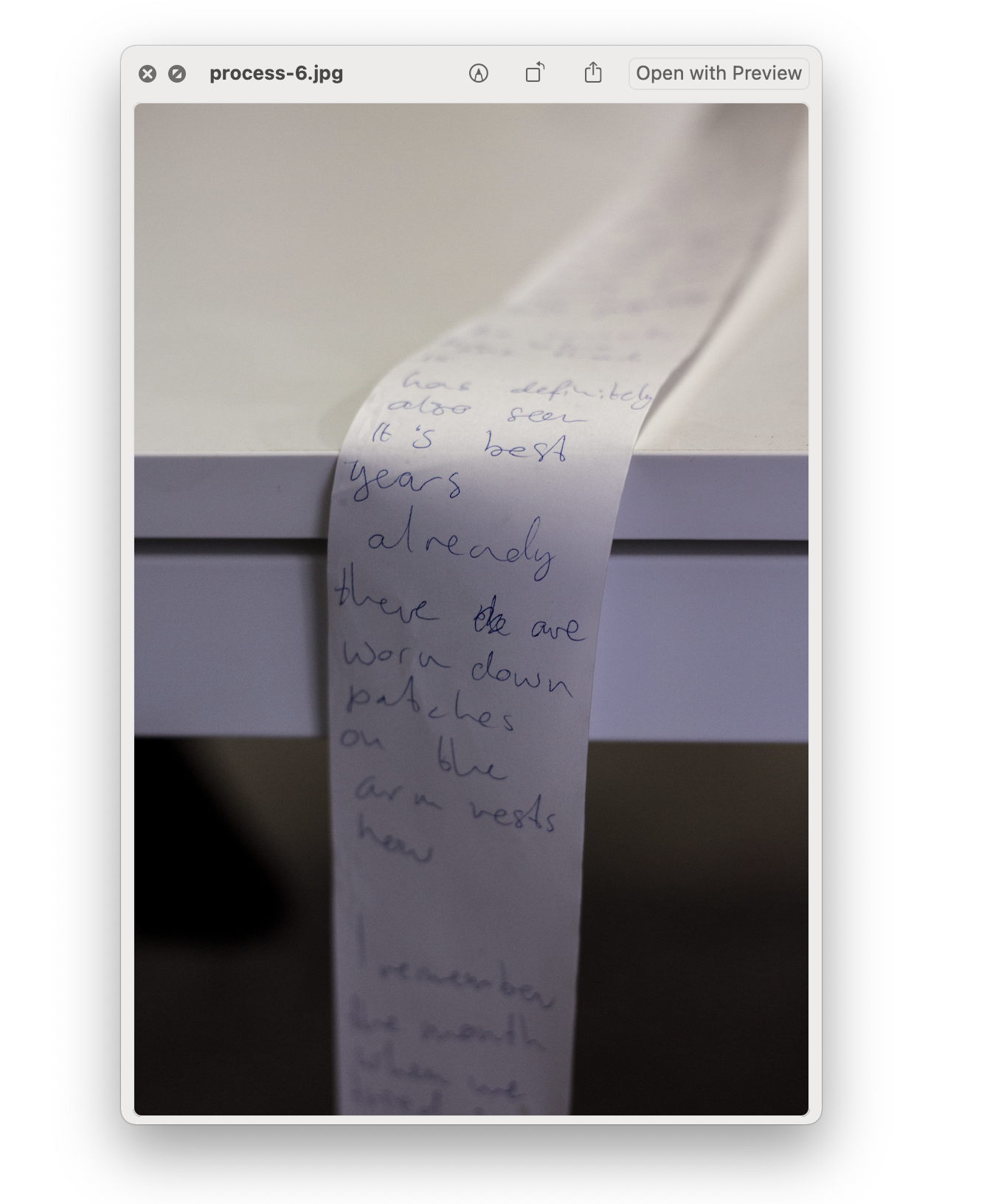
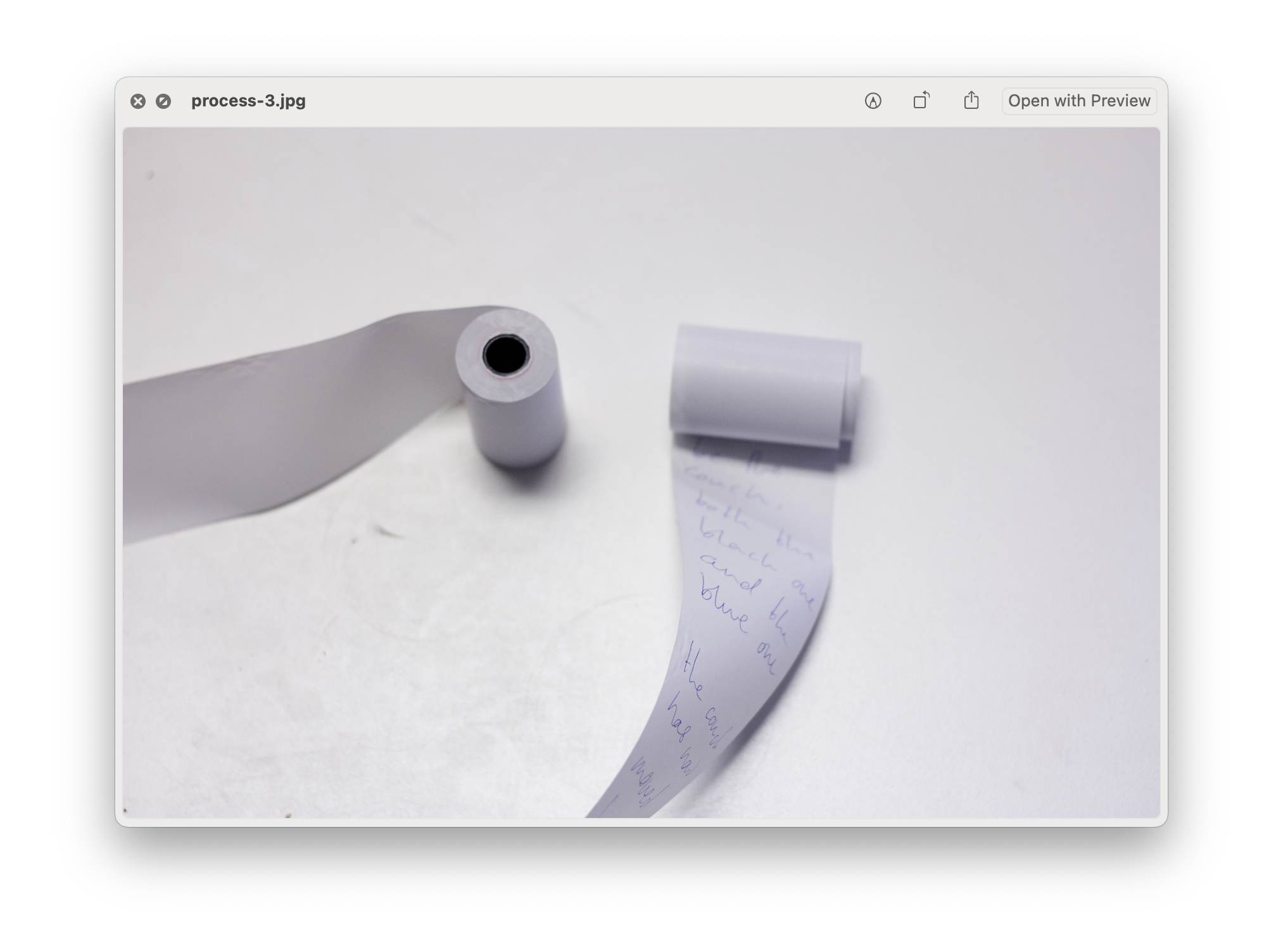
In the exploration of how I could showcase the embodiment of memory in a spatial aspect, one of the tactics that was central to my work, was mapping.
Mapping, as an artistic action, takes both a literal and more conceptual approach here. In the literal sense, it is a direct representation. In the performance, I am physically mapping out a space, placing text in places where what it references, existed once in real form. Not in the space here, but in the space of the memory. It is showcasing the knowing of a place, which in return, presents a perspective of authority. I am showing you this map of things you have never seen, and will never see either. It gives me authority over this representation, and allows you as a visitor to physically step into this.
The mapping functions as a tactic, or process, to find one’s way through real and described space. I am presenting you with a non-linear path for you to explore. There are things to find, to read, to connect to. My markers, here the texts on the floor, are a specific web of interconnected references. They exist in spatial connection to each other, whilst not necessarily existing in real time together. These markers investigate a notion of time, and with that, how memories grow and are processed over time.
One core aspect of the mapping of a memory in this work, is how it aims to provide a notion of how a body exists within a space —within the map. During the performance, but also through the records afterwards, the navigation of a body in this space is the main connector. How the audience exists within the representation of this space, how I have existed within this space, and how those relations now overlap.
In the experimentation with this approach, I worked with a lot of different formats. I tried writing on walls, on rolls of paper, on loose sheets or post its, I tried mapping spaces with tape, with rope, or measuring places. I investigated how this ‘intervention’ of the space made an impact on the work. Rather than adding something on top of the physical space, I wanted the map to become part of the space. I liked the idea of mapping a floorplan a lot. It was a rather direct translation of a map, and allowed for a real life spatiality to really come to the front of the experience. Now an audience could literally step into this memory, and physically walk through it.
One main point of commentary or feedback that I kept receiving in the progress of the performance, was that the actions I was doing on the floor, during the physical mapping and active remembering, were the strongest in the work. Seeing me in that state of mind of remembering, and how it activated and rippled from connection to connection, was interesting and engaging for people to see. This was great input and really helped in the further shaping and balancing of the different actions to the performance and to see how to play them.
_____documentation of installation
_____‘Yesterday, last Monday, December 24th’
___experimenting with materials
There was a lot of experimentation, investigation, and thought involved in the choosing of the materials for this performance.
With the mapping being a central aspect of the work, the esthetics of these actions, and thus the materials, were conscious decisions. Besides adding to the visual appearance of the work as a whole, their use and thus added meaning, needed to align with their role and place within the structure of the work.
___existing on the desktop
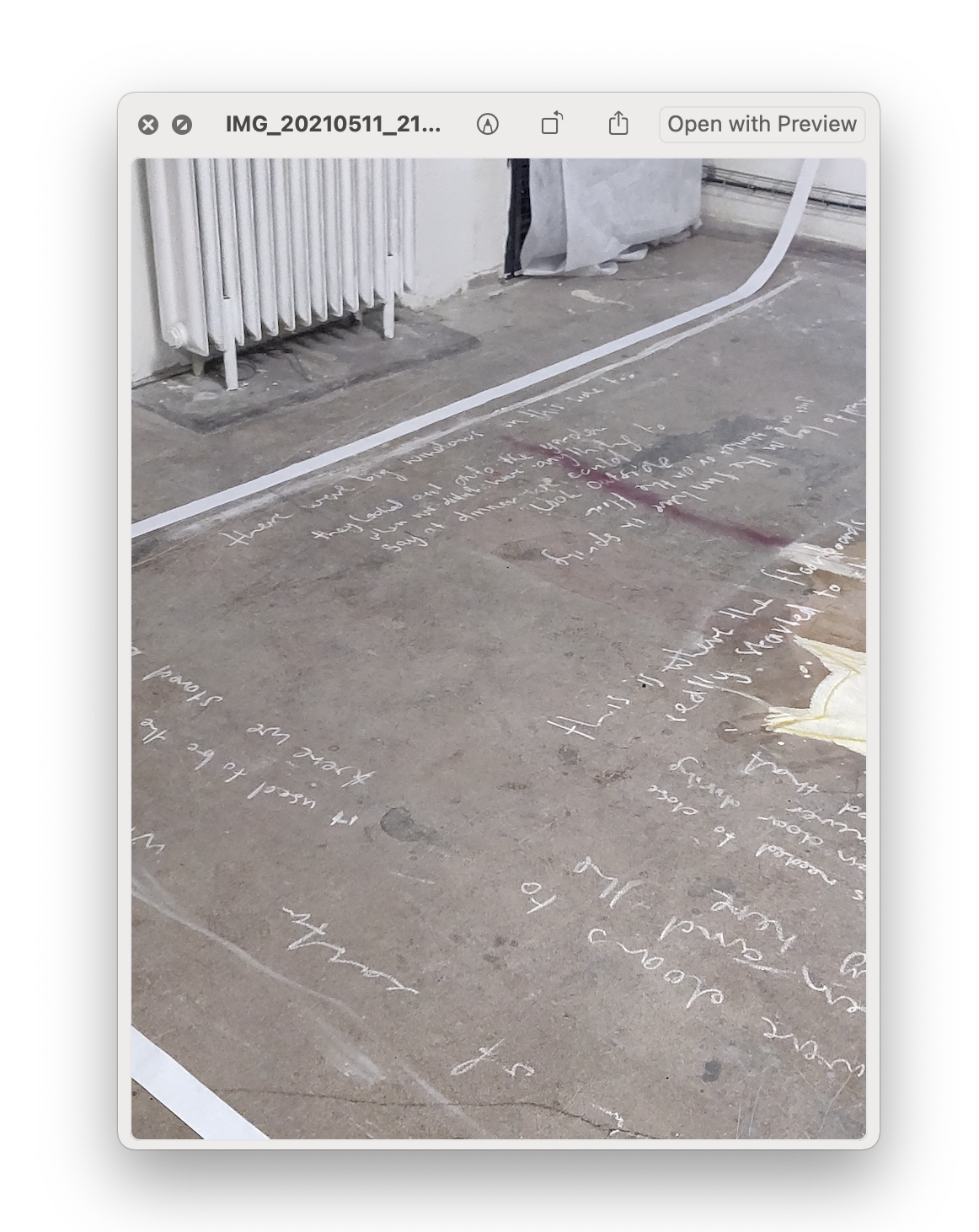
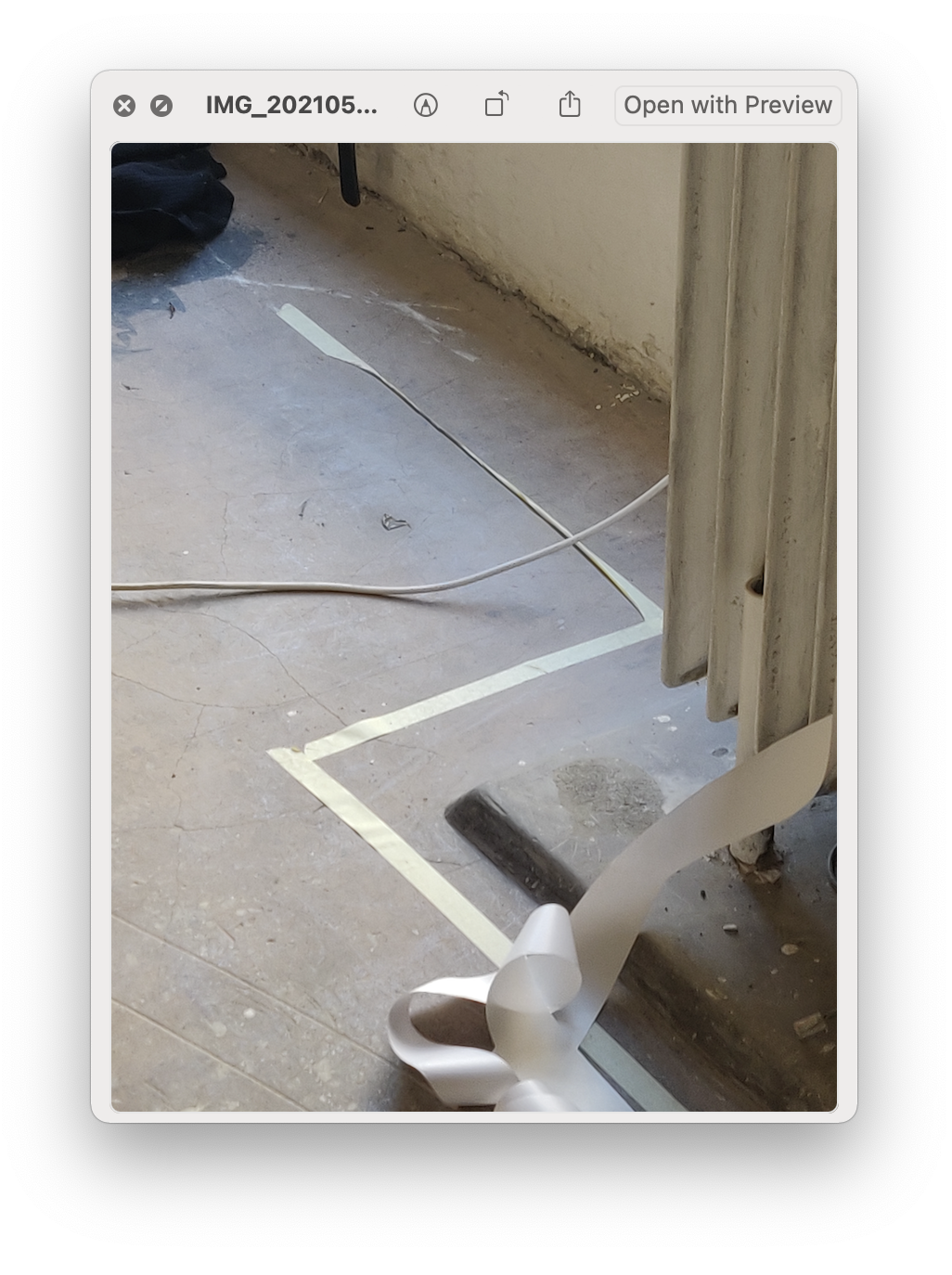
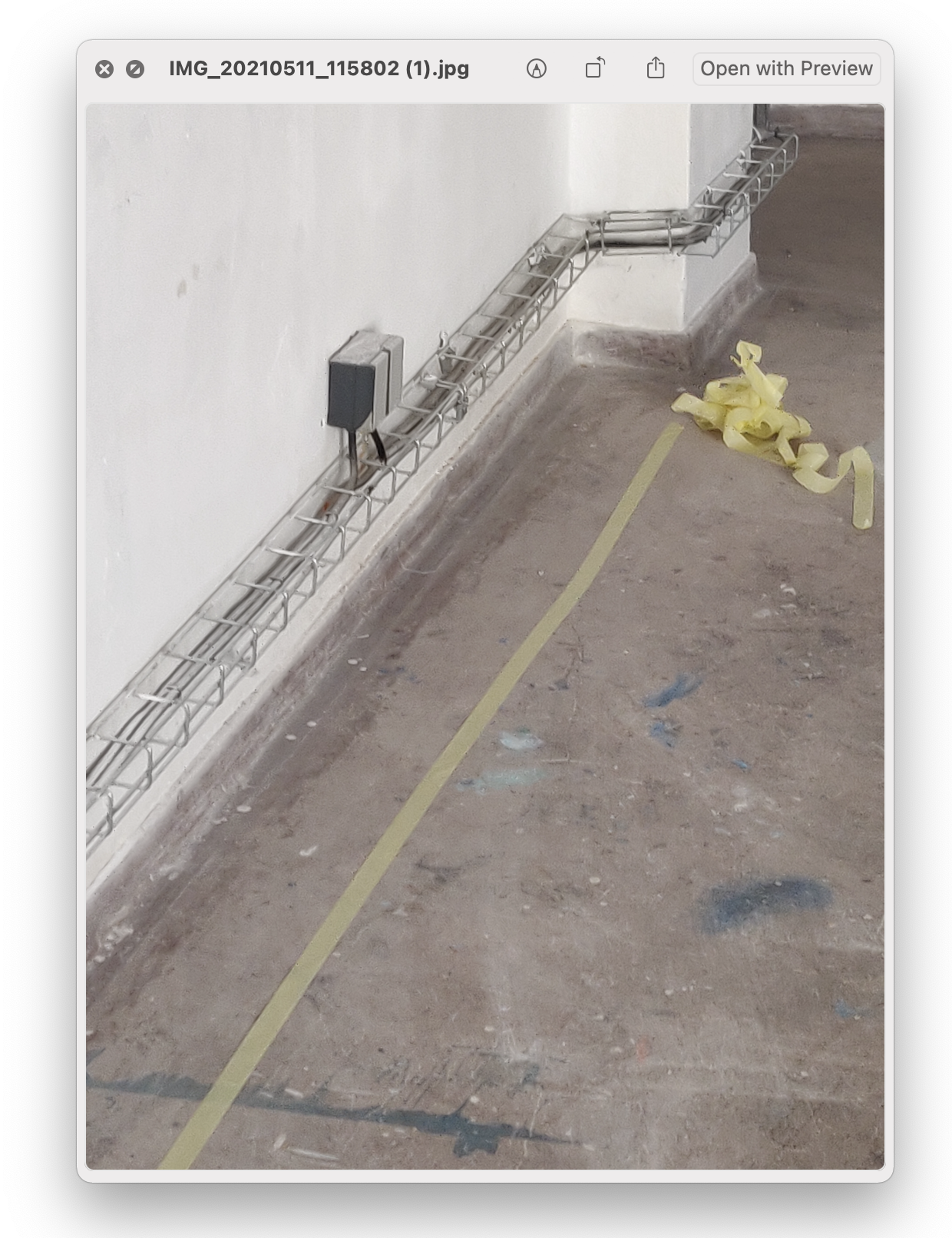
The esthetic of marking, mapping and placing, can take shape in many different formats. Where I originally experimented more with post it’s or paper rolls (materials with an intended purpose of marking ‘onto’ something, as an added value to the existing thing they mark) I later found that working with materials intervening directly into the space worked a lot better visually. I initially opted for writing with markers directly onto the floor, but with the texture and stains on the floor itself, the black on the background was not so visible. I later made several trials with chalk, which I liked. Their temporal character, the markings were literally being smudged in the process of the performance, has a beautiful quality to them. It really embodied the durational aspect of the performance, in the way that the decay was a result of the exploration of the mapping, of it’s existing that was growing with time. I ultimately also tried out chalk or paint based markers on the floor, but they took too long to dry, so that logistically did not work well for the performance.
Art that exists on the desktop. I have lately been very intrigued by this. It started as research I did for my thesis, exploring archives and archiving structures, both on and offline. This was an element that I wanted to explore in this work. I wanted to seek how I could create something that could be explored not only by me, but also by an audience, both whilst viewing it in a space, as well as afterwards, maybe online. I always see my art as functioning as an archive or within an archival structure in the way that it explores accumulation, often in a non linear narrative.
Archives, like art, hold a certain level of authority to authorship. We account value to authorship and individuality, and in similar ways, to spatial existence. When presented in the right context, art is given a certain value. This is particularly interesting in relation to the digital space. How does this authority and authorship play out, when the interaction with or creation of art is much more fluid between the artist and the viewer.
The ways how we view and own art online are inherently different and are being challenged by many contemporary artists.
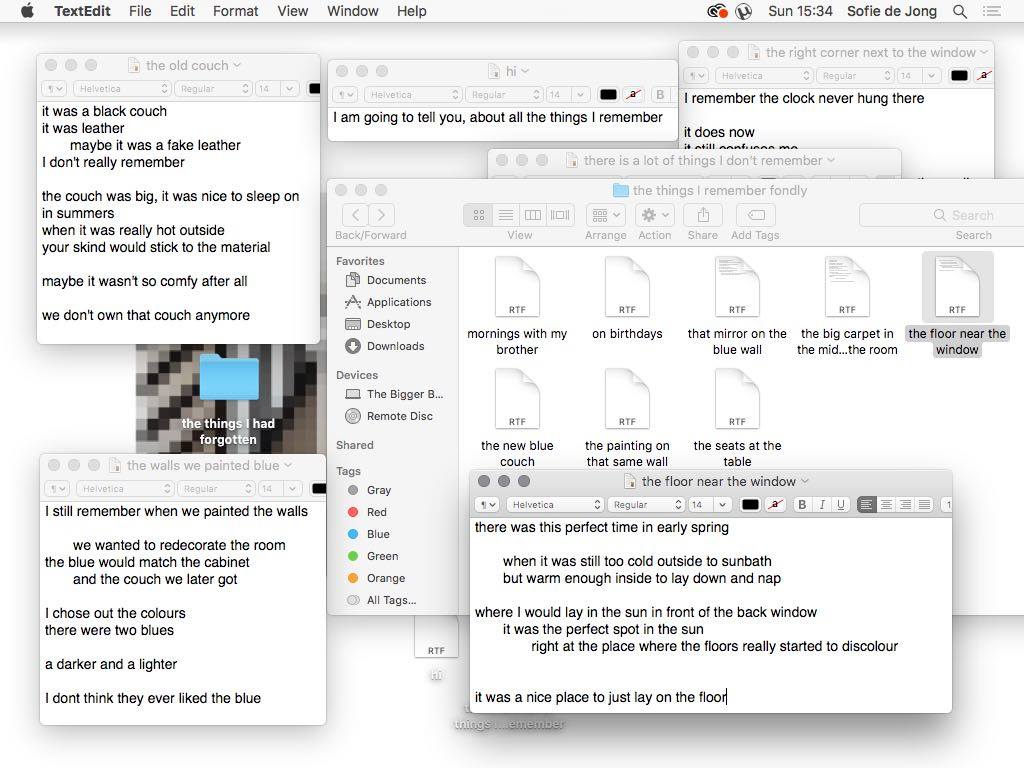
When art exists online, for anyone to access with a simple click, it changes the context for viewing. When there is no museum or institution to claim importance by it’s spatial existence, we can start to see different value being given to works that solely exist in this digital format. We can (almost) always download anything we see through the browser window, regardless of an artist’s intent. The contrast between the browser —the confined but connected digital space— versus the desktop —the intimate personal digital space— and how art exists on either, is especially interesting in this conversation.
The interaction with the desktop in my work, from the perspective of the viewer takes two different forms. The reader encounters the desktop, with it’s directory of folders and files, first, as a performance. They see the artist interact, create, tell them a story. It is only afterwards, that the desktop is, so to say, opened up as a thing to discover. It becomes a thing to explore. The archive asks you to become engaged through acts of opening and viewing, feeding our voyeuristic desire to click and see everything contained.
After the performance, the work is contained as a .zip folder, to be accessed by anyone. It holds the content that existed on the desktop, as well as the documentation of the performance.
___final documentation of project